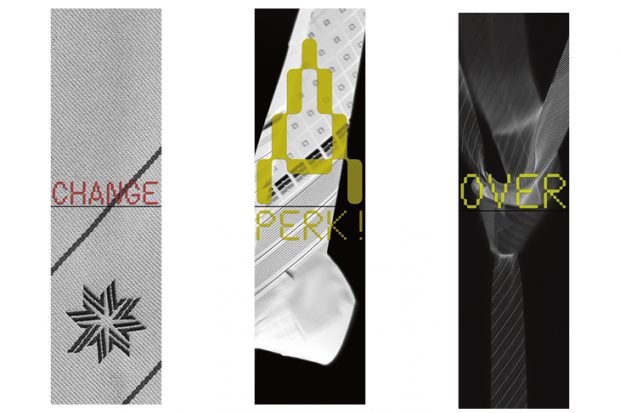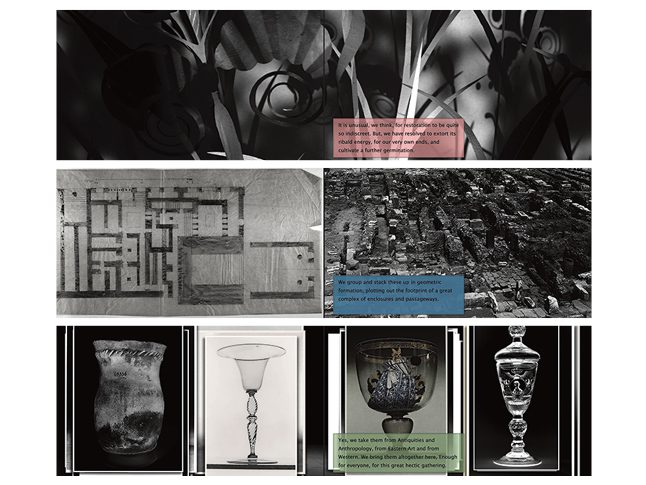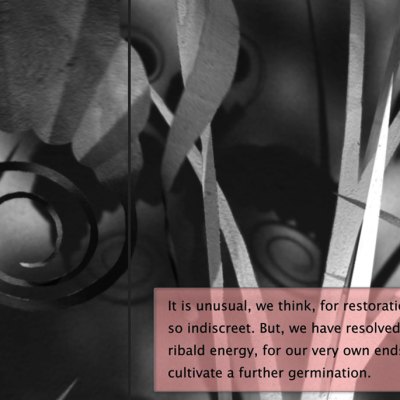One of the first things I notice on entering Elizabeth Price’s studio in south-east London is a storage unit with drawers filled with art supplies – ink and paints, plaster, glues, tape and string. This is a little unexpected because since the mid 2000s Price has worked exclusively in video, producing around a dozen works that fuse fiction with social and cultural history – most recently a trilogy looking at different forms of modern labour and protest. On the morning of my visit last December, she is just back from the United States, where she installed and attended the opening of her exhibition of the first two parts of the series – FELT TIP and KOHL (both 2018) – at the Walker Art Center in Minneapolis (until 1 March 2020; it will also be showing at Nottingham Contemporary from 16 February–6 May 2019). Price is jet-lagged; her watch is still set to Central Standard Time. But she is cheerful as she sets about making coffee and explains the presence of the art supplies – the video editing suite is upstairs, but ‘I make a lot of my own props, so use a surprising number of “traditional” materials.’ Perhaps this shouldn’t be so surprising, after all. For the first decade or so of her career, Price – who completed her BFA at the Ruskin School of Art in 1988 and MFA at the Royal College of Art three years later – did not make a single video work.
Three stills from FELT TIP (2018), Elizabeth Price. © Elizabeth Price

‘I’d gone through art school when there was nothing; even in my early years of teaching there was hardly any access to video. And to be honest, I’ve always been interested in cinema, but I never had a special interest in the history of moving image.’ Instead, without much critical or commercial attention, she quietly produced a body of conceptually driven, politically engaged work in three dimensions: spare installations of text and objects, performance projects and photographs. In 1999, she completed a practice-based PhD at the University of Leeds. Her career was going the same way the majority of young artists not born into creative dynasties go. (Both of Price’s parents were teachers; they didn’t know anyone ‘who did anything remotely like [art]’.) Very little documentation of Price’s work, mostly exhibited in small London galleries, exists from this period. More significantly, she didn’t feel satisfied with the work she was making; she wondered if in its minimal aesthetic it was doing a better job of looking like the art you were meant to see in galleries than of communicating any of the things she was trying to say. Eventually, she became fed up. ‘I just decided, fuck that, really. If I was going to carry on being an artist at a point when it was very, very difficult, I had to make art that was a bit more like the person I was. More candid, explicit, prepared to engage – more talky, I suppose.’
Still from A PUBLIC LECTURE & EXHUMATION (2006), Elizabeth Price. © Elizabeth Price

Price’s first video installation was A PUBLIC LECTURE & EXHUMATION (2006). The work was the continuation of a project begun several years earlier, when Price was working as an administrator for the Hackney Museum in north-east London, to fulfil the bequest made in 1927 by Alexander Chalmers, who left his collection of art to the borough of Stoke Newington, in what is now north-west Hackney, along with a set of instructions relating to its use. Price, who had initially been tasked with cataloguing the bequest, set out to honour these instructions, which stopped being carried out in the 1960s. The video opens with a dramatic piano chord and the words ‘WELCOME’ in the bold red type that has become something of a signature for Price. The narrators introduce themselves as the ‘former libraries committee’ of the borough before embarking on a guided tour of their one-time ‘jurisdiction’, its streets and civic institutions, and the ‘scattered trace[s]’ of the Chalmers Bequest. Appropriately, the lecture takes the form of a PowerPoint presentation, complete with clunky word art and unsubtle transitions between images. Price explains that she was actively seeking to move away from the self-consciously tasteful, ‘pious, complacent’ aesthetics of post-conceptual art, to find a more ‘popular’ way of incorporating text into her work. ‘I suppose I thought the terrible vernacular of PowerPoint was probably equivalent to how conceptual art languages would have been experienced when they were first used, before they were sanctified.’ Besides, she had no professional training in video production, so PowerPoint and other simple forms of presentation software seemed like a good place to start.
Three stills from A RESTORATION (2016), Elizabeth Price. Courtesy the artist and MOT International and Brussels; © Elizabeth Price

In the intervening decade, in works that mine and reimagine histories from that of Arthur Evans’s excavation of the ancient city of Knossos in the early 20th century (A RESTORATION [2016]) to an exhibition of conceptual art that took place in 1972, Price has become a master of video and its installation. FELT TIP, KOHL and the still-to-be-completed txt∫ərz are rapidly paced multi-channel affairs of image, text, and sound brought together with razor-sharp editing. In their utterly absorbing nature, they are more akin to pop videos than most video art, which may not be a coincidence; as a student, Price was more involved with the music scene than the art world. A frequently cited fact of her biography is that in 1986 she was a founding member of indie-pop group Talulah Gosh (she left later that year to form The Carousel with another singer, Gregory Webster). She credits music with first giving her the ‘idea of being an artist’. ‘The post-punk new wave era was one in which music became accessible to people – it was possible to be in bands, to perform, to make records, for them to be distributed on a very small scale. It gave me an idea of a conceivable world in which you might make things that it would be possible to share, and that you might belong to a community of people involved in that. That was the first kind of art world I was involved in, and continues to be really influential in my attitude to art.’
In her videos striking visuals and sounds – whether in the form of musical tracks or narrative voiceovers – are key to Price’s goal of making work that speaks to audiences. If the art world’s response is anything to go by, she has more than achieved this aim. Beginning in the mid 2000s she began receiving a steady stream of fellowships and residencies and was shortlisted for a series of prizes, including the Max Mara Art Prize for Women in 2010 and the Jarman Award the year after. Then in 2012 came both a Paul Hamlyn Award and the Turner Prize for her single-channel video THE WOOLWORTHS CHOIR OF 1979 (2012). Writing in the Telegraph, Richard Dorment described his experience of watching the work as ‘20 of the most exhilarating minutes I’ve ever spent in an art gallery’. Since then Price’s works have been exhibited in major institutions and at biennials around the world, and in 2016 she was invited to curate a Hayward Gallery Touring exhibition that was presented in Manchester, Bexhill-on-Sea and Swansea. Later this year she will have her first full-scale retrospective, at the Whitworth Art Gallery in Manchester.
Still from THE WOOLWORTHS CHOIR OF 1979 (2012), Elizabeth Price. © Elizabeth Price

The widespread showing of Price’s videos doesn’t mean, however, that they are always straightforward, or easy to understand. It usually takes a while to grasp the subject matter – or even to work out who is speaking. In the manner of A PUBLIC LECTURE & EXHUMATION, each of Price’s films is narrated by an imagined ‘composite, institutional’ voice – whether a former libraries committee or, as in her new trilogy, an anonymous chorus of administrative workers. In early works the narrators’ words were drawn from existing documents, ‘really messed around with’; now Price writes her own scripts in the jargon-laden vocabularies of civic documents, academic texts, and commercial press releases. In a further development, in a piece titled K (2015), Price introduced a synthetic voice that performs the typed script – a reminder, she says, that the narrators are ‘not really human […] that insofar as they exist in the film they exist in some kind of institutional context’. The still and moving images shown on the often multiple screens of each installation are of a similarly composite nature, bringing together an apparently disparate array of archive footage, newly shot video and animation. ‘In a way, I imagine the narrators making the choices about how this imagery is selected and presented,’ Price tells me. In THE WOOLWORTHS CHOIR she decided to combine an illustrated lecture on the architecture of a gothic church choir, a recording of the 1960s girl band the Shangri-Las, and news clips of a fatal fire at a branch of Woolworth’s in Manchester in 1979. The shared element, identified by the nameless narrators about a third of the way into the film, is a ‘twist of the right wrist’ – a gesture that can be found in all three strands. This strategy of interweaving loosely, laterally connected material – constructing ‘a fabric of relations’, as Price puts it – is also at work in FELT TIP, KOHL and txt∫ərz. The videos move from the fashion in the 1970s and ’80s for men’s neckties with patterns that evoke electrical devices and digital networks to the decline of coal mining in the UK – images, sounds and themes bleed from one work into the next.
At one point in our conversation, Price mentions the French theorist Gilles Deleuze, who with Félix Guattari developed the theory of a system of relations termed the ‘rhizome’. Is this concept relevant to her work, I wonder? ‘I would never, I would prefer not to [use the term],’ she replies immediately, before taking a pause. ‘There are always too many things that are different, you risk losing the sense of the specificity of your own decisions if you attach them precipitously to a theoretical model.’ That’s not to say Price is not interested in theory – it’s just that an understanding of formal and technical decisions comes first; specifically, an understanding of ‘what a cut means, or whether it’s a film or video, or the impact of the digital’. For Price, it is in the digital realm that we can most clearly see the possibilities of the non-hierarchical sets of connections imagined in her films. ‘I’m interested in the sense of the digital, not as a radically new kind of experience of the world and images, but actually this quite dirty, confused, mixed-up realm, in which everything washes up, a promiscuous space of many, many different kinds of things.’
Two stills from KOHL (2018), Elizabeth Price. © Elizabeth Price

Central to Price’s view of the digital is a refusal to separate it from the textures, objects and spaces of the physical world, which distinguishes her from the many other artists exploring digital technology, who are preoccupied with the more futuristic possibilities of robots, virtual reality, and blockchain. As she explains, ‘The majority of stuff that exists in the digital – it’s probably only just still true – but historically the majority of it wasn’t made in the digital. So many of the images that are accessible on the internet will have migrated through a series of technologies, through photography, through some graphic technology, some reprographic technology, and often through different generations of digital technology.’ Hence the concern in her videos with different collections, archives and histories, and the preponderance of historic photographs and filmed footage of physical movement, materials and three-dimensional spaces, alongside unmistakably digital elements such as synthetic voices and electronic music soundtracks. Similarly, when in 2016 she curated the Hayward Gallery Touring exhibition, Price was keen to include works in as many different media as possible. The show, which she describes as a meditation on different states of the ‘horizontal’, included excerpts of films by Andy Warhol, Rainer Werner Fassbinder, and Carolee Schneemann, projected on screens suspended from the ceiling, as well as sculptures by Edward Onslow Ford and Brancusi, a 16th-century painting by Roelant Savery, and a text work (from which the show’s title, ‘In a Dream You Saw a Way to Survive and You Were Full of Joy’, was borrowed) by Jenny Holzer. ‘It was great to open up crates and get things out,’ Price says. ‘Installing video is really horrible. It’s not creative, it’s technical and very, very precise in ways that make you fearful – if there’s a problem with video, the whole thing can stop working. It’s like the sculpture just evaporates because one tiny thing’s wrong.’
Still from txt∫ərz (2018), Elizabeth Price. © Elizabeth Price

For now, though, Price is back in the editing suite. She is working on the final cut of txt∫ərz, a preliminary version of which was shown at Morley College in London in 2018. The film will complete the trilogy begun by FELT TIP and KOHL, which looks at ‘hierarchies of labour and forms or means of expression’ – from the manual work of the former coal miners in KOHL, via the tie-wearing admin staff in FELT TIP, to the ‘executive work’ of the teachers who are the protagonists of txt∫ərz. As well as being perhaps her most explicitly political works to date – a response to what Price describes as the ‘rather grim social reality’ of the UK over the past decade – the three pieces also comprise her first series. I ask what motivated this shift in format. ‘I’m quite slow, and I get totally immersed in making a film. It becomes really difficult towards the end because I have almost no perspective, a total kind of monomania. I thought if I decided to work in a series I could work that intensively but then give myself some perspective by also working on something else intensively.’ Price laughs. ‘It’s like by multiplying the manias I could have a bit more of a handle on it. And I’ve really enjoyed it actually.’
‘Elizabeth Price: Felt Tip’ is at Nottingham Contemporary until 6 May.
From the February 2019 issue of Apollo. Preview and subscribe here.



